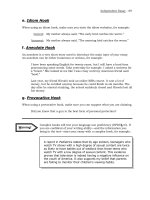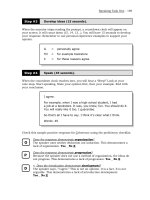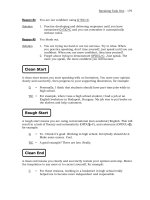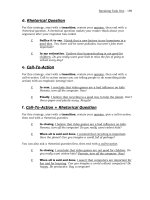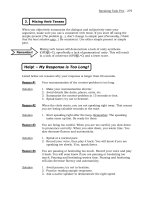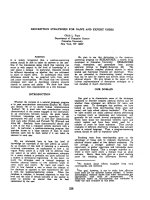Forex Strategies for High and Low Volatility Markets_6 pptx
Bạn đang xem bản rút gọn của tài liệu. Xem và tải ngay bản đầy đủ của tài liệu tại đây (1014.09 KB, 32 trang )
that the market proved us correct right away so that we did
not have to sit through any kind of drawdown.
The RSI is also effective in identifying support and resistance
in the market by monitoring the different levels of the RSI. Just
as we can draw trendlines that act as support and resistance
on the price chart, we can draw trendlines on an RSI chart that
may act as support and resistance. By going back and study-
ing the charts, you will find that often we will see the same lev-
els proving support or resistance on the RSI, depending on the
current trend. In a very strong market the RSI 50 level will
prove support, as price will bottom at the same time the RSI
finds support at this level. In a more modest up move price
may bottom out when the RSI is at 40. In a downtrend we may
see price start to top out when the RSI gets to around 60.
In Figure 7-16 we see how a resistance line for the RSI
between 60 and 55 for the week of August 11 telegraphs a
down move in EURUSD, whereas the support level angling up
from approximately 30 to 35 a week later precludes an up
move. The RSI is also effective at showing divergence, as can
be seen in Figure 7-16, where the RSI bottoms on August 15
and then creates an uptrend before the price actually bottoms
on August 19.
Just as the market respects the support and resistance levels
created by isolated lows and highs, the RSI’s isolated lows and
highs become significant support and resistance levels and are
well worth reviewing.
The RSI is an important indicator in that it is an excellent
gauge of underlying strength as well as being an effective
determinant of support and resistance independent of price
points on the chart.
Mastering the Currency Market
180
Commodity Channel Index
The Commodity Channel Index is a momentum oscillator that
is considered a leading indicator. It was designed by Donald
Lambert to identify cyclical turns in commodities. Lambert
believed that commodities (or financial markets) move in
cycles, with highs and lows coming at fairly regular intervals.
The calculation involves taking the central pivot point of a
market minus the 20-period simple moving average of that
pivot point and dividing that number by 0.015 multiplied by
the mean deviation. For our purposes, the calculation is not
important, as the various chart packages do this for us; it is
how the indicator is used that is noteworthy. Like all centered
oscillators, the CCI fluctuates above and below a zero line.
Technical Indicators
181
Figure 7-16 RSI Provides Support and Resistance Independent of Price
Lambert’s analysis concentrated on movements above 100 and
below Ϫ100. What was noteworthy about Lambert’s original
calculation using a 0.015 constant was that it ensured that the
majority of CCI values would fall between 100 and Ϫ100. When
the market moves above 100, it is thought to be entering
an uptrend and a buy signal is given, and when the market
moves below the Ϫ100 CCI reading, a sell signal is generated.
Similarly, a move up through Ϫ100 would be seen as a coun-
tertrend buy signal, whereas a move down though 100 would
be seen as a countertrend sell signal. By not considering price
action between the 100 and Ϫ100 levels, the trader avoids much
of the sideways or countertrend price action and seeks out
the times when markets enter into cyclical moves. It was also
Lambert’s belief that if a market has a statistical tendency
toward a quarterly cycle—which would be approximately 60
trading days high to high or low to low—the CCI should be set
to one-third of that, or 20 days. If a market has a six-month
cycle, or 120 days, the CCI should be set to one-third of that, or
40 days. The CCI also can give signals generated from
trendlines drawn on top of the indicator. As in all momentum
oscillators, divergence between price and the CCI is considered
significant as well. Figure 7-17 shows how a CCI trendline
signal followed by a move above 100 provided timely buy
signals in USDJPY. Assuming that a quarterly cycle is a good fit
for a currency, we went with a 20 length CCI in this example.
The CCI is another versatile tool in the trader’s toolbox in
that it gives both trend and countertrend signals, attempts to
filter out signals in ranging markets by concentrating on the
100 and -100 levels, gives us divergence, and allows us to draw
trendlines on the indicator itself.
Mastering the Currency Market
182
Average True Range
The average true range (ATR) is not an indicator as much as it
is a tool that gives us a market’s average range over a specific
period and accounts for price gaps from one day to the next or
from one week to the next. Another word for what it is helping
to measure is the market’s current volatility, which is the rate
of the change in price over time: The faster price is moving, the
higher the volatility is, and the slower price is moving, the
lower the volatility is. The indicator was developed by J. Welles
Wilder and is one we can use to determine our stop placement,
or how much we will risk on a trade. We cover stop placement
orders in more detail in Chapter 12 but need to introduce you
to this calculation and show you why and how we use it.
Technical Indicators
183
Figure 7-17 CCI Shows Its Versatility
Figure 7-18 is a chart of EURUSD for the period from late
2008 to early 2009, with the ATR at the bottom of the chart.
This indicator gives us the average true range for the previ-
ous 14 sessions. The reading on this chart for February 1 is
0.0237, which tells us that the ATR over the previous 14 ses-
sions was 237 pips. Therefore, we can surmise that if we take
a position in this market and want to place our stop far
enough away from price to avoid being stopped out on a ran-
dom intraday price spike, this information will be helpful. We
may decide that a 2 ATR stop would be appropriate—placing
our stop over 474 pips away from our entry—in that it would
give us enough room to stay in the trade and not have to
worry too much about price stopping us out prematurely.
We are not recommending this as a strategy, just showing you
how it can be used as one.
Mastering the Currency Market
184
Figure 7-18 ATR Gives the Market’s Current Average Range or Volatility
The ATR is helpful because we can judge at a glance how
much a market is moving. That will help us determine how
much we would need to expect to risk or if we could even
afford to take a position in that market
In Chapter 9 we will cover ways to tie together the techni-
cal indicators we use, and in Chapter 13 you will see them
again in a trading plan we’ve constructed that we encourage
you to use as a model for your own trading plan.
Technical Indicators
185
This page intentionally left blank
CHAPTER
Trading
Techniques
M
arkets definitely have a cadence or a rhythm that a trader
needs to tune in to. Often it’s not enough to discern
direction and look for signals until we’ve taken a moment to
scan our longer-term charts for patterns in both price and time
that a market may be exhibiting.
Time patterns play nearly as important a role in technical
analysis as price patterns do but are talked about only rarely.
When we refer to time patterns, we are not referring to mar-
ket cycles such as those one might find in commodities or to
sophisticated measurements based on Fibonacci ratios but to
simple tendencies a market move may be exhibiting that can
be seen easily on a chart and can give us an edge in our trad-
ing. Often a market will exhibit predictable behavior when it
is correcting, as can be seen in Figure 8-1. The USDJPY fell
into a pattern of taking 12-hour countertrend corrections that
were easy to spot; the last one happened over the weekend
187
8
and so was a bit over the usual 12 hours, but it still was easy
to spot.
Figure 8-2 shows a GBPUSD daily chart in which one can
see a bull market that was exhibiting a tendency toward
10-week corrections and then 8-week corrections. Symmetry
like this is common in most markets and is something experi-
enced traders quickly home in on.
Figure 8-3 shows the EURJPY displaying a clear pattern
of two-day corrections through June and July 2006. Time
patterns such as these tend to show up in corrections (reac-
tions) more than in trending (impulsive) markets, and
that determination is in itself intuitive in that the timing of
Mastering the Currency Market
188
Figure 8-1 Pattern of 12-Hour Corrections in USDJPY
Trading Techniques
189
Figure 8-2 Weekly Pattern to Corrections in GBPUSD
Figure 8-3 Simple Pattern of Two-Day Corrections
reactive behavior should be more predictable than that of
impulsive behavior.
As quickly as markets show repetitive behavior, the pattern
fades away and shows up at a later date with a slightly differ-
ent cadence and a longer or shorter distance. Instead of trying
to anticipate a pattern in market movement, it is far better to
observe the market’s current behavior and take the signals the
market provides. “Take what the market gives you” is an old
adage among traders, and for good reason.
It is important to remember that technical analysis is an art,
not a science.
Dow Theory
Dow Theory is a trend-following school of thought named
after Charles Dow, one of the original publishers of the Wall
Street Journal, for his analysis of nineteenth-century market
price action. The theory was refined by S. A. Nelson and
William Hamilton and published by Robert Rhea in a book
titled The Dow Theory in 1932. Hamilton’s 1922 book The Stock
Market Barometer is also a cornerstone of this theory.
Dow Theory covered trends extensively, breaking them
down into three categories. The first is the primary trend,
which lasts from a few months to many years and represents
the dominant market direction: a bull or bear market. The pri-
mary trend is identified from the current direction of the peaks
and troughs or pattern of highs and lows and closes on the
daily or weekly charts. The trend is up if there is a series of
higher highs, higher lows, and higher closes. The trend is down
Mastering the Currency Market
190
if there is a series of lower lows, lower highs, and lower closes.
Primary moves also are characterized by relatively steady or
impulsive movement in one direction.
The secondary trend is a price movement that can last from
a few weeks to a few months and is defined as a corrective
stage for a market when it deviates from its primary direction
and retraces anywhere from one-third to two-thirds from
the previous move. Secondary moves are characterized
as reactive price actions and often are faster than primary
moves. Hamilton considered secondary moves normal in
the course of market movement and healthy in that they can
offset excessive speculation.
Daily fluctuations, or the short-term trend, last from a few
hours to a few days—rarely longer than a week—and repre-
sent very short-term reactions and corrections that often are
brought about by fundamental developments or scheduled
news releases.
In Robert Rhea’s book, which is a partial compilation of Dow
and Hamilton’s original editorials, he laid out several assump-
tions that must be accepted if one intends to follow Dow Theory.
The first assumption is that the primary trend cannot be
manipulated. In a widely followed liquid market such as a
major stock index or a country’s currency, manipulation over
a long period is not possible. Even 100 years ago Dow and
Hamilton felt that despite manipulations over the short term,
major markets were too big to be controlled by anything other
than the true underlying structure of supply and demand over
the long term.
The second assumption is that markets discount everything.
This means that the price the market is trading at represents
Trading Techniques
191
all the information currently available regarding economic
activity, interest rate levels, currency pricing, expectations of
inflation, political developments, and product or commodity
innovations. The unexpected can and will happen, but it gen-
erally will influence the very short-term or secondary trend,
leaving the primary trend in place. This is a widely known
tenet of technical analysis now, but it was groundbreaking
when it was published at a time when the majority of
investors pored over fundamental information in the previous
day’s newspapers for hints about what would happen in
tomorrow’s market.
The third assumption is that the theory is not perfect. It does
not provide a way to outperform the averages every time but
outlines a set of guidelines to assist traders in interpreting
where a major market is in its cycle.
The theory also laid out rules for trend identification, using
criteria such as a higher low in a downtrend followed by a
higher high to confirm a trend change or reversal. This is con-
sidered common knowledge now among traders but serves as
a reminder to beginning as well as experienced traders to pull
up the long-term charts and always be aware of such devel-
opments and patterns.
The theory also is known for using one related average or
market to confirm the action in another, closely connected
average. A hundred years ago the two markets used were
the Dow Jones Industrial Average and the Dow Jones Rails
Average, the precursor to the Dow Jones Transportation
Index. It was widely believed that the Rails Average would
lead the Industrial Average because before industries
could expand, they had to purchase and transport the raw
Mastering the Currency Market
192
materials needed for expansion. This early activity would
show up in a railroad company’s receipts before an increase
in business activity for companies and businesses on the
industrial side. Because of this relationship between indus-
tries, a move in one index generally had to be confirmed by
a move in the other. Figure 8-4 is an example of this as we
see the Dow Jones Industrial Average daily chart in dis-
agreement with Dow Jones Transportation Index (the mod-
ern Rails Average) in the third quarter of 2008 as the
Industrial Index makes a lower low and the Transportation
Index does not. The market then goes sideways until the
Transports make a lower low in late September 2008 and
both indexes fall sharply in unison.
Trading Techniques
193
Figure 8-4 Transports Confirm Bear Market with Lower Low
This divergence between the two related indexes can tell us
as traders that we do not want to press short positions in the
Industrials until we have confirmation of a move lower in the
Transports in the form of a lower low. Once the Transports con-
firmed with a lower low, we saw an acceleration of the down
move by both indexes.
Dow Theory also breaks down market movement into three
different stages. The first stage is marked by accumulation for
a bull market or distribution for a bear market. This is followed
by the middle stage, in which price movement accelerates as
the fundamentals reinforce the price trend and price movement
becomes impulsive. In the third stage there is exhaustive price
action as rampant speculation kicks in and the market literally
runs out of new participants because investors and speculators
are all positioned the same way. These definitions are still help-
ful to market students and traders.
Hamilton and Dow covered volume and the way it lends
validity to breakouts and trending behavior. They also covered
sideways patterns, or what we’ve come to know as trading
ranges. Much of what the theory covered evolved into the pat-
tern-recognition techniques that we outlined in the section on
chart patterns in Chapter 6.
A drawback of Dow Theory that is common to trend-fol-
lowing studies is that those systems are often late in confirm-
ing market movement. This leads investors to enter positions
after a significant move already has taken place and leaves
them to sit through adverse price corrections.
This section is meant to introduce Dow Theory, not define
it. We encourage anyone with an interest in the theory to take
an in-depth look at this school of thought by obtaining
Mastering the Currency Market
194
Hamilton and Rhea’s original works, which are available
online. You will see after studying Rhea’s The Dow Theory
where some of the ideas for the next two schools of trading
we are going to cover may have sprung from.
Elliott Wave
The Elliott wave principle is primarily a trend-following school
of technical analysis that describes market movements as
waves. In Elliot wave theory each market movement, or wave
pattern, is designated with a numeric label—1 through 5—and
a behavioral designation—impulsive (trending) or reactive
(corrective). It is named after the market analyst R. N. Elliott,
who published his ideas in two books: The Wave Principle (1938)
and Nature’s Laws—The Secret of the Universe (1946). Elliott
wrote that a market movement, whether a bull move or a bear
move, always could be broken down into five separate waves,
with three being impulsive, or trending, moves and two being
corrective, or countertrending, moves. The two corrective
waves separated the three trending waves. The trending waves
themselves could be broken down into five smaller waves of
the same sequence as the overall move, and the corrective
waves often fulfilled predictable retracements and broke down
into three waves—two impulsive separated by one correc-
tive—that are labeled A-B-C.
Elliott believed the Fibonacci summation series was the basis
of his wave pattern. He theorized that it is crowd psychology
that moves the markets, and since that was no more than the
collective actions of individuals and since individuals, like all
Trading Techniques
195
living things, are rhythmic, their actions can be predicted. He
also proposed that there are waves within waves, with each
smaller time frame mimicking the larger formation, a phe-
nomenon we now know to be fractal geometry.
Figure 8-5 shows an example of a possible Elliott wave count
on the daily USDJPY chart for the down move in 2007 and
early 2008. We see three impulse moves down labeled 1, 3, and
5 and two corrective waves in between labeled 2 and 4 that
show predictable retracements of approximately 50 percent
and 66 percent. The move is symmetrical, with the impulse
moves being roughly equal in height, lending predictability to
the extensions, and with the corrective waves being marked by
Mastering the Currency Market
196
Figure 8-5 Elliot Wave Pattern in USDJPY
the choppy sideways price action common to countertrend or
corrective price activity. Figure 8-5 also highlights one of the
propositions of Elliott wave theory, which is that wave 3 is the
most dynamic wave of the three impulse waves.
Figure 8-6 shows an example of a five-wave rally in the Dow
Jones Industrial Average futures in 2007 followed by a textbook
A-B-C correction. Note how wave 1 and wave 5 are nearly
identical in size and how wave 3 is easily the largest and most
dynamic. On the A-B-C correction that follows, the A wave is
nearly identical to the C wave, continuing the symmetry of the
up move it corrected.
According to his detractors, one of the drawbacks of Elliot’s
theories is that they are too subjective, with analysts needing
Trading Techniques
197
Figure 8-6 Elliot Wave in Dow Jones Industrial Average Index
to update and adjust their wave counts regularly as the mar-
ket moves. Ellioticians seem to say that market direction is pre-
determined but then adjust their wave counts when the market
doesn’t play out the way they had scripted it to.
We feel that the trader and market forecaster Cynthia Kase
summed it up best in her 1996 book Trading with the Odds:
“Elliott’s theories about the market in general and his view that
there is a natural law that governs the market are correct in
broad terms.” The fact that traders such as Kase, along with
Bill Williams and Justine Williams-Lara, the traders and
authors of the Trading Chaos trilogy of books, continue to use
the wave count in their trading also gives Elliott’s theories
credibility.
Our description of the Elliott wave here is relatively short
considering the weight the theory carries with many profes-
sional traders. Elliott’s wave theory and observations and use
of Fibonacci numbers were groundbreaking, and there is no
shortage of excellent descriptions of how his theories are
applied in today’s market, including Kase’s works.
W. D. Gann
W. D. Gann is a name that many professional traders know
well. Gann’s 1942 book How to Make Profits in Commodities is
a classic trading text that is full of sound advice covering top-
ics from market trends, to isolated highs and lows, to swing
trading, to volume analysis, to individual psychology and
money management. Gann talked about the importance of
studying the difference between a time period’s opening price
Mastering the Currency Market
198
and closing price long before other analysts were talking
about information that we now know is embodied in
candlestick charts.
Despite his insistence on “never bucking the trend,” Gann
is best known for his countertrend theory that markets move
in increments of one-eighths. He believed that if one took a
completed market movement from top to bottom and divided
it into eight equal sections and then extended those levels into
the future, they would have predictive value. The levels
would take turns providing both resistance and support, with
the four-eighths, or 50 percent, level having particular signif-
icance in determining the trend. The three-eighths and five-
eighths levels are also of particular importance in providing
pivotal levels and determining the trend. When a market
stalled at a Gann one-eighth level, it generally meant that
market would retreat back to the previous level, and when
a market closed through a Gann level, it meant it generally
would continue its current direction to the next level.
Gann also considered the seven-eighths level to constitute
significant resistance and the one-eighth level to constitute
significant support. Many of these occurrences can be seen in
Figure 8-7. The Gann levels for this chart were anchored in
2000 when we measured the bear market of 1990 to 2000 and
divided it into eighths and then extended those levels out-
ward. Note the importance of the 50 percent level in 2003,
2004, and 2005 and the importance of 0.625 (five-eighths) in
2007 and 2008.
There were also 1.125 and 1.250 levels and Ϫ0.125
and Ϫ0.250 levels. According to the Gann expert T. Henning
Murray, of Nashville, TN, once the market closed above 1.250
Trading Techniques
199
(ϩ2/8), the old 50 percent level (4/8) became the new 0.00 level
(0/8) and the Gann lines shifted higher. Similarly, if price
closed below Ϫ0.250 (Ϫ1/8), the old 50 percent level (4/8)
became the new 1.00 (8/8) level and the Gann lines shifted
lower. This shifting of the numbers gives the Gann lines a
trend-following capability as they expand with the market.
Ironically, Gann’s extension teachings on the benefits of trad-
ing with the trend, his theory of dividing market moves by
12.5, and his belief in the value of swing trading led many of
his followers to concentrate on countertrend trading. The
drawbacks to following Gann’s tactics today come not from his
original works but from the interpretations of those works by
Mastering the Currency Market
200
Figure 8-7 Monthly EURJPY Chart Broken Down into One-Eighth
Gann Lines
analysts and brokers trying to capitalize on Gann’s name. Gann
also was credited with using astrology in his analysis, largely
as a result of his followers’ interpretations. Gann also believed
that fractal geometry was at work in the markets, with the dis-
tance between the larger one-eighth sections breaking down
into smaller one-eighth sections.
Buying Strength and Selling Weakness
One of the most widely made mistakes by nonprofessional
traders results from not understanding the concept of buying
strength and selling weakness. Professional traders, in contrast,
make a living by taking advantage of this concept. Let’s say
there were two currency markets in clearly defined down-
trends. One market was higher by 0.58 percent on the day, and
the other market was higher by 0.23 percent on the day.
According to your methodology, both markets were giving sell
signals, and you were instructed to choose between the two.
Which market would you sell: the one up 0.58 percent or the
one up 0.23 percent?
The correct answer is you would take the sell signal in the
market that was up 0.23 percent because that was the weaker
market. When we are given the choice, we always sell weak-
ness and buy strength.
In the two charts in Figure 8-8, both AUDUSD and
EURUSD are in extended downtrends. Both markets correct,
or retrace, at the same time in late September 2008. We can see
on the charts that AUDUSD retraced or rallied approximately
36 percent of the previous down move and EURUSD retraced
or rallied approximately 46 percent of the down move. We can
Trading Techniques
201
say that on the basis of the distance of this retracement,
EURUSD is stronger than AUDUSD because it retraced more.
When we get sell signals after the corrections in the form of
price closing below short-term bull trendlines, AUDUSD
falls over 10 percent and EURUSD falls only 5.6 percent.
Clearly, we would have been well served by being short
both pairs. However, we would have been better served—
more profitable—by being short two AUDUSD rather than
one of each.
To bring home to you how important it is to recognize weak-
ness and strength and trade on this information, let’s say that
having seen how EURUSD was stronger than AUDUSD after
that September correction, we decided to buy EURAUD at the
Mastering the Currency Market
202
Figure 8-8 EURUSD Retraces More, Indicating That It Is the Stronger of
the Two Markets
end of September, based on the axiom of buying strength and
selling weakness. Figure 8-9 shows the EURAUD chart.
This chart provides a great example of why professional
traders always buy strength and sell weakness. The price cor-
rections in September gave market participants a clear look at
which markets were weaker than the others, and traders voted
with their money, giving us a very impressive rally in
EURAUD in early October.
Buying a currency that is lagging the other currencies relies
on the same logic as betting on a horse that is in last place
three-quarters of the way through the race for no other reason
than that the horse is trailing. It makes no sense to initiate
trades by buying a currency that is weak relative to the others
or selling one that is strong relative to the others.
Trading Techniques
203
Figure 8-9 EURAUD Jumps Sharply in October 2008
This page intentionally left blank

